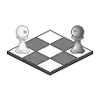by avoiding blunders what I meant included not being negligent, although I should have made the title of this forum How to Convert Winning Positions Quickly
@Hunter5200 said in #21:
> by avoiding blunders what I meant included not being negligent, although I should have made the title of this forum How to Convert Winning Positions Quickly
There is no reason to win as quick as possible, you only need to maximize winning chances.
> by avoiding blunders what I meant included not being negligent, although I should have made the title of this forum How to Convert Winning Positions Quickly
There is no reason to win as quick as possible, you only need to maximize winning chances.
@Hunter5200 said in #21:
> by avoiding blunders what I meant included not being negligent, although I should have made the title of this forum How to Convert Winning Positions Quickly
@Autofill said in #22:
> There is no reason to win as quick as possible, you only need to maximize winning chances.
Ok, thanks :) I have only been playing for 7 months. I still have a huge amount to learn.
> by avoiding blunders what I meant included not being negligent, although I should have made the title of this forum How to Convert Winning Positions Quickly
@Autofill said in #22:
> There is no reason to win as quick as possible, you only need to maximize winning chances.
Ok, thanks :) I have only been playing for 7 months. I still have a huge amount to learn.
@Hunter5200 - Here's a very good article on how to stop blunders, by GM Avetik Grigoryan. It's a good read. - :]
- chessmood.com/blog/stop-blunders-in-chess -
- chessmood.com/blog/stop-blunders-in-chess -
@Skittle-Head said in #24:
> @Hunter5200 - Here's a very good article on how to stop blunders, by GM Avetik Grigoryan. It's a good read. - :]
> - chessmood.com/blog/stop-blunders-in-chess -
thank you!
> @Hunter5200 - Here's a very good article on how to stop blunders, by GM Avetik Grigoryan. It's a good read. - :]
> - chessmood.com/blog/stop-blunders-in-chess -
thank you!
@mkubecek said in #10:
> I would just like to emphasize the word "every". It's important to recheck even in case of "obvious" moves like recaptures
An illustrative example I've seen this morning: one moment of lack of focus and...
According to the timestamps, black spent 32 seconds on 46... exf2 so it clearly wasn't a quick thoughtless move. But asking the basic question "What is the best (or most likely) reply to my intended move?" would have helped.
> I would just like to emphasize the word "every". It's important to recheck even in case of "obvious" moves like recaptures
An illustrative example I've seen this morning: one moment of lack of focus and...
According to the timestamps, black spent 32 seconds on 46... exf2 so it clearly wasn't a quick thoughtless move. But asking the basic question "What is the best (or most likely) reply to my intended move?" would have helped.
Just a little example that I do not always follow the reco which I gave above as one rule for "blunder avoidance". My reco was "Look at each piece and check which squares it can reach within two moves. Just let the pieces quickly move around the board in your mind: By doing this you will have the patterns in mind which can create a tactic in the position."
Even in seemingly simple positions like the one below that could be useful: I want to walk my king with Kf6 towards the white pawn on g6 but first I need to move by bishop away so that the knight cannot take it. Without much thinking (short on time) I played Bc7? .
If I would have let the knight dance a little bit in my mind I would have deteced the two-move option Nf7-g5-e6 just as one possible path. That would have sharpened my view for the fork which can occur after 1. ... Bc7 2. Ng5+ Kf6 3. g7 Kxg7 4. Ne6+ and I would have seen that instead of Bc7 and I need to place the bishop on the safe square b8 ... but I was lucky: My opponent also did not saw it.
lichess.org/study/viL5l7aX/eZPDotvt
Even in seemingly simple positions like the one below that could be useful: I want to walk my king with Kf6 towards the white pawn on g6 but first I need to move by bishop away so that the knight cannot take it. Without much thinking (short on time) I played Bc7? .
If I would have let the knight dance a little bit in my mind I would have deteced the two-move option Nf7-g5-e6 just as one possible path. That would have sharpened my view for the fork which can occur after 1. ... Bc7 2. Ng5+ Kf6 3. g7 Kxg7 4. Ne6+ and I would have seen that instead of Bc7 and I need to place the bishop on the safe square b8 ... but I was lucky: My opponent also did not saw it.
lichess.org/study/viL5l7aX/eZPDotvt
This topic has been archived and can no longer be replied to.



